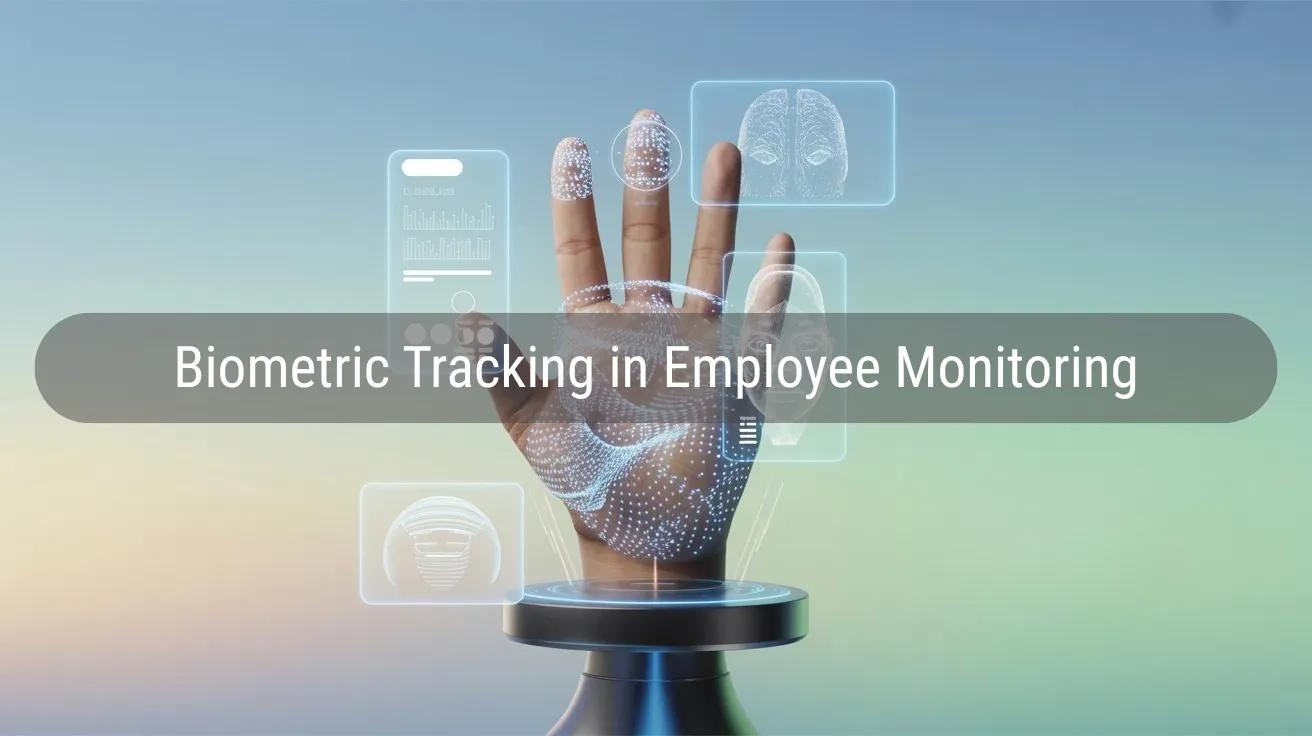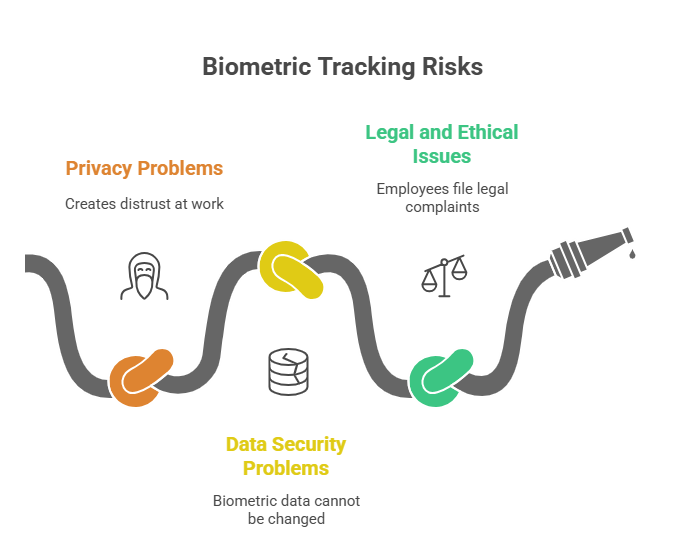Biometric Technology in Employee Monitoring: Security or Invasion?

Summary:
-
Biometric tracking is monitoring employees through fingerprints, eyes, facial scans, and voice recognition.
-
It stops buddy punching and time theft, increases efficiency, improves security, and sets clear records.
-
Privacy concerns, data security, and legal compliance are the major challenges of biometric tracking.
The biometric market is now worth $60.94 billion and growing fast. Because this technology is solving real workplace headaches. It stops buddy punching, strengthens security, and cuts down errors. And companies are taking notice.
While biometric systems offer powerful benefits, they also raise serious privacy concerns, like private data leaks and legal issues.
Let's break down how they work, what they can do for you, and what risks you need to know about.
In this article
- Biometric tracking definition
- Advantages of biometric technology
- Dangers of biometric system in employee monitoring
- Correct way of employee monitoring
What is Biometric Tracking Technology?
Biometric tracking is a method where fingerprints, face scans, eye scans, and voice recognition are used to ensure identity with pinpoint accuracy.
Compared to typical password or ID card verification, biometric data is almost impossible to copy. So, you use them to protect sensitive systems, offices, or devices.
For example, you can install a facial scanner to confirm employee identity before stepping into the office. This keeps your organization safe from unauthorized access.
Biometric monitoring, however, can also be used to watch people, where they go, and what they do. And it makes attendance and access control effortless.
This is why some companies nowadays employ biometric tracking as they seek ways to stop time theft.
Prevent time theft with accurate data
Why Biometric Tracking Is Grabbing Attention?
Remote & hybrid work is nothing new anymore. With its monumental popularity, newer issues like monitoring workers and attendance tracking have surfaced. To tackle them, companies are adopting biometric monitoring systems as old timecards are easy to fake.
On top of that, organizations save money when they use biometric time tracking software. Workers can't clock in for their friends or colleagues anymore. The system does all the heavy lifting, like recording biometric check-ins and outs, and cross-checking them with the database.
Now these tools do two things very well. One is that they stop attendance fraud and reduce errors. The latter is that it cuts down paperwork significantly.
Such benefits are the main factors behind the value of biometric technology, which is $60.94 billion in 2025. And Precedence’s research shows that the market for biometric systems will reach $338.83 billion by 2034.
That said, employee monitoring tools are getting more advanced. About 58% of companies now use a biometric access control system. They track more than just confirming identity via fingerprint or facial scans. Rather, watch where workers go and how long they stay in certain areas.
However, this brings some deal-breaking privacy concerns. That is why GDPR in Europe and CCPA in California limit what companies can track. These laws control how biometric data is collected, stored, and used. You’ll learn more about this later in this article.
Monitor employees without violating privacy
Key Benefits of Biometric Tracking in the Workplace
Using a biometric attendance system at work has several clear advantages. Here are the main benefits with examples.
1. Stopping Time Theft
Workers can share time cards or PIN codes. But they can’t share faces or fingerprints, can they?
Biometric attendance tracking does exactly this by introducing facial, fingerprint, or eye scanning. And it effectively prevents "buddy punching" and time theft. [Source: ResearchGate]
Again, manual time entry, paper logs, or ID cards often have mistakes. Plus, they are easy to tamper with. When a biometric tracking system is active, it makes sure the record matches only the correct person.
This entire process works well in a biometric entry-exit tracking system for places that need strict access control. Thanks to the biometric tracking software solutions.
More Efficient Process
Imagine a construction site with hundreds of workers. In such an instance, when shifts change, workers don't need to wait in line to punch cards or remember long passwords. They just scan their fingerprint or face. This makes clocking in and out faster and easier.
A fingerprint scan can stop wage theft as well. It also gives proof if a worker says the employer's time records are wrong. Because biometric software records exact clock-in times by itself. As a result, the HR team can do more with fewer errors.
Enhanced Security
Old school password login systems fail because 81% of them use weak passwords. And this makes them vulnerable to skilled hackers.
The biometric access method, on the other hand, provides robust security. Because, for the most part, you can’t just go ahead and guess or recreate biometric data like passwords.
For example, construction sites using mobile biometric tracking can limit access to approved workers only. Again, hospitals and banks use biometric systems to protect records or data centers.
Accountability & Clear Records
Biometric tracking makes attendance records that cannot be altered. This is a master solution that protects both employers and workers.
As these systems keep detailed logs, they show exactly when each person entered or left. This is especially helpful during audits and reviews. And it reduces bias or suspicion because employers can see accurate attendance and work hours.
Know that when you set up a biometric system as a security tool rather than spying, it balances tracking work with employee privacy.
Ensure employee privacy and bring accountability
Risks Involved with Biometric Tracking
Biometric tracking systems may make security better, but they have serious risks that are often overlooked. Companies need to think about these before making a decision.
Privacy Problems Create Distrust at Work
Constant biometric tracking can create a culture of spying instead of trust. When workers know their fingerprints, faces, or typing are being watched, it puts pressure on them.
In reality, however, 54% to 59% of companies use app and website usage data to find work problems. But the number of biometric monitoring systems is growing. And this is where the concerns start to appear.
You see, biometric data is much more personal. Unlike tracking activities, it shows a person’s private information. And naturally, this feels too personal to most workers.
Best employee monitoring practices to ensure privacy
Data Security Problems
Biometric security is great, but it has a scary downside.
In 2019, security experts found something alarming. A company called BioStar 2 accidentally left more than 27 million records wide open on the internet. We're talking about fingerprints, face scans, photos, and passwords - all just sitting there.
This wasn’t the result of an advanced hack, but rather a simple security misconfiguration. And that's the real problem. Even the advanced biometric systems can become dangerous if you fail to protect the data properly.
Once biometric identifiers leak, they can’t be cancelled or changed. So it creates a lifelong security risk for those who are affected.

Legal and Ethical Issues
Biometric monitoring can hurt trust and employee morale. And worse, they get angry and file legal complaints against you.
Just like in 2024, Amazon faced legal problems in Europe. Reports showed warehouse workers being watched through biometric signs. This made many workers angry at the Amazon France Logistique authority.
Eventually, the French data privacy guardian CNIL fined them €32 million. [Source: BBC]
Monitor employees without breaking laws
Better Ways to Monitor Productivity without Going Too Far
Biometric tracking systems make people worry about privacy at work for all the logical reasons.
Now, instead of using too much biometric tracking, employers can use better methods. And those will improve work and security at the same time. The goal is simple: track what matters for work without being invasive.
This is crucial, as a 2023 Deloitte report shows that 83% companies have “workforce analytics maturity” that leads to higher employee turnover. Some unverified sources say that the rate is 15%.
To tackle this, here are five simple ways to track work the right way:
Ensure Transparency to Build Trust
Start by telling workers exactly what you're tracking and why. Because trust is the very foundation that your business runs on. So, before using any employee monitoring system, make it clear which data you'll collect and how you'll use it.
Regularly, share work reports with your team so that they can see their own numbers.
As soon as employees know the reason behind your tracking, they're more likely to cooperate.
Respect Employee Privacy with User Activity Data
Monitor only work activities. Do not monitor personal information. This is the de facto privacy standard for workplaces, yet many companies miss it.
Therefore, keep track of the apps and websites employees visit during work hours. Check how long they take for a task and the idle time. And to keep things transparent, take screenshots that both you and employees can view in real time.
While you do this, don't get carried away and start tracking every keypress or reading private messages. This becomes counterintuitive sooner than you might think. Heck, it might bring legal complications. The worst part is that it shows you don’t trust your staff.
So, only use data that you need to understand work patterns. This protects worker privacy while still giving you useful info about workflow and problems.

Use an Ethically Compliant Monitoring Tool
Pick a software that follows privacy laws like GDPR and CCPA. Also, look out for data security and clear privacy policies. Again, an ideal solution should let you adjust settings and ask for permission to track.
The right tool respects both business needs and worker rights without needing biometric tracking.
Just to let you know, Apploye offers these features while focusing on productivity rather than watching too much.
Install Workforce Analytics Software to Optimize Workloads
Use tracking to balance work amounts, not be a big brother who constantly watches workers. Good work tracking software shows you which team members have too much work and which can do more.
It finds work patterns, helps stop burnout, and shows process problems. Apploye's tracking dashboard gives you live updates on project progress and team capacity.
This data helps managers make better staffing choices and help struggling workers before problems get worse. So, focus on making things better, not spying.
Use Biometrics as a Security Measure
Save fingerprint technology, iris scanning, hand geometry, or voice identification for security only. These work well for building access or a protected login.
However, fingerprint tracking or retinal scanning software shouldn't be used for daily work checks or attendance. Keep these biometric technologies limited to high-security areas like server rooms or data centers. As a result, it will keep security benefits intact while avoiding the privacy concerns that come with constant biometric tracking.
Real Life Application of Biometric Monitoring
Using Biometric Access in Construction Sites
A big construction project in Colombia started using face recognition technology to check who comes in and out of the site. They also used tablets with fingerprint readers.
Here's how it worked:
- Workers walking into the site scanned their faces at the entrance gates
- Workers are using handheld tablets to verify their identity
- The system tracked who was on site and when
The results were impressive. Unauthorized people trying to get in dropped by 90%. The company could also see real-time information about how many workers were on site and their attendance records.
Biometric Recognition in Healthcare
Geisinger Medical Center in the USA started using facial recognition to identify patients.
Patients scan their faces, and the system finds their medical records precisely. So they don’t need to wait in a long line. Also, the risk of mismatching patient history is almost zero. The entire process works seamlessly.
What makes it so amazing is that the hospital doesn't have to deal with lost or wrong wristbands anymore. As a result, treatment delay is reduced significantly.
Biometric Identity Management in Banking
DBS Bank in Singapore started using iris scanners at its ATM booths. And it allows clients to complete transactions without any physical cards. The machine just scans their eyes and voila!
The results have been impressive as well. Transactions now take 42% quicker than before, with 31% more customer satisfaction.
On top of that, people using the eye-scanning system had 37% fewer problems with locked accounts or forgotten passwords.
The bank saves money on support costs, and customers get faster, easier banking without worrying about wrong passwords or carrying cards around.
Biometric Tracker at Retail Shops
Facial and fingerprint scanners are now common in large grocery stores. They act as an employee timesheet solution. Plus, they effectively put an end to “buddy punching” for good.
With these new biometric systems, only the real employee can clock in. This saves stores a lot of money each year.
After COVID, face scanning became even more popular. That's because employees don't have to touch the same keypad or punch cards that everyone else uses. So, it's more sanitary.
The Big Disadvantage of Biometric Tracking
As great as biometric attendance tracking is, the downsides can be cruel, especially for medium to small-sized companies. So much so that lawsuits and fines can throw them out of business.
Big corporations are not safe from this either. Any violation or data exploitation can cause devastating financial damage and ruin a company's reputation.
For example, Ken Paxton, Attorney General of Texas, sued Google for collecting biometric data without consent. Although they have agreed to pay $1.4 billion, their reputation is in jeopardy. [Source: CNBC]
Productivity Tracking Should Not Compromise Privacy
Biometric systems like fingerprint scanners or facial recognition are great for workplace security and tracking attendance. They're accurate and efficient.
But collecting this kind of personal data comes with big privacy responsibilities.
A 2023 survey by the American Psychological Association showed that when companies monitor employees too closely, it backfires. Because workers get unhappy, and regulators start asking questions.
Also, heavy-handed surveillance breaks trust and can get you in legal trouble, as I’ve discussed earlier.
But the good news is you don't have to choose between tracking productivity and respecting privacy. You can have both.
This is where tools like Apploye come in. Instead of tracking fingerprints or faces, Apploye ethically monitors work activity. You can see productivity levels, track time, and understand how apps are being used—all without collecting sensitive personal data.
Closing
The future isn't about choosing between knowing what's happening and respecting your employees. It's about using the right tools the right way. Be transparent. Only collect what you actually need. Pick solutions that put ethics first. Your employees will trust you more, and you'll stay on the right side of the law.
FAQs
What does "biometric" mean?
Biometrics is basically using your body to prove who you are. Think of things like your fingerprint, your face, your voice, or even your eyes. Each person has unique features that make them different from everyone else.
How can I check my biometric status?
Contact whoever collected your biometric information in the first place. If it is a government agency, they usually have a website or phone number you can use to check your appointment or see if your verification went through. And if it's for work, just ask your HR department or the person who manages the system. They can help you see your records.
Why turn off biometrics on iPhone?
Turning off Face ID and fingerprint unlock on your iPhone can keep you safer in some cases. Police or hijackers can make you unlock your phone with your face or finger. But they can't force you to tell them your passcode. So if you turn off biometrics, you're better protected. It also stops your phone from unlocking by accident.
How does a biometric attendance system work?
A biometric attendance system works like this: when you arrive at work, you scan your fingerprint or face. The system checks if it matches what's saved in its memory. If it's you, it marks you present and records the time.
How do biometric systems integrate with time and attendance software?
Biometric systems connect directly to time and attendance software through built-in integrations or APIs. When employees scan their fingerprint or face, the biometric device automatically records their clock-in time and sends it to the attendance system.
What is a biometric visitor management system?
A biometric visitor management system helps you know who's coming into your building. It works by scanning things that make each person unique – like their fingerprint or face. Instead of having visitors sign in on paper, the system automatically records who they are and when they arrived. It's like a high-tech guest book.
How are biometric authentication systems reshaping security and privacy measures?
Biometrics uses body parts like your face or fingerprint instead of passwords. This makes security better and faster and stops fraud. Also makes the login process simpler. But it creates privacy risks as biometric data is private and can't be changed. That’s why companies use encryption, store data on your device, limit who can see it, and ask permission. Just to keep everything safe.
What are the objectives of a biometric security system?
These systems help keep unwanted people out of a restricted zone. And they make secure access effortless. You don't need to worry about forgetting passwords or losing ID cards anymore. Plus, they keep track of who goes into important areas.
How does a fingerprint-based attendance system compare to other methods?
Fingerprint systems work better than old-school punch cards or PIN codes. Because you can't share your fingerprint with someone else. With cards or codes, one worker could clock in for another worker who's running late. This is called "buddy punching," and it's basically time theft. Fingerprints stop this completely.

